Traditional Italian Easter Bread
This Traditional Italian Easter Bread is a soft sweet brioche dough formed into wreaths or braided. Coloured eggs are baked into the bread and the bread is sprinkled with lots of nonpareils. Festive and bright for the Easter Holiday.
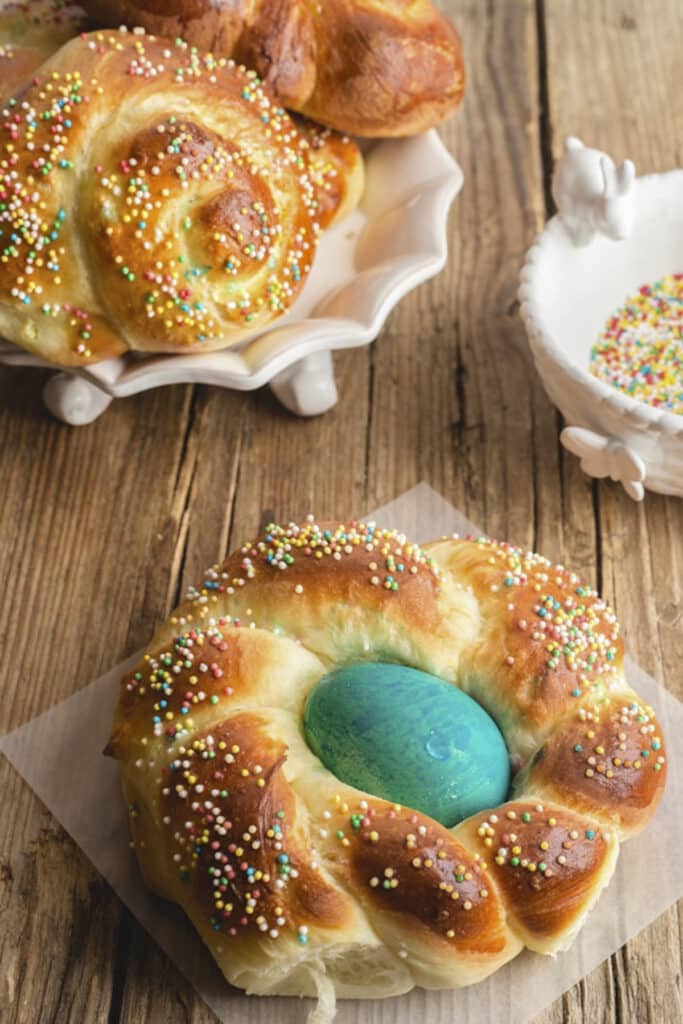
Another very popular yeast bread is a recipe called Casatiello Napoletano which is a savory stuffed bread.
I absolutely love Brioche Bread and of course this Sweet Soft Bread is a must in any Italian home on Easter. I wanted to find a true Traditional Italian Recipe and I came upon this recipe Brioche di Pasqua from a fellow Food Blogger, Chiara from Chiarapassion.com.
How to make An italian easter bread
In the bowl of a stand up mixer whisk together the flour, salt, zest and sugar, make a well in the centre and add the milk and yeast, mix together with a fork.
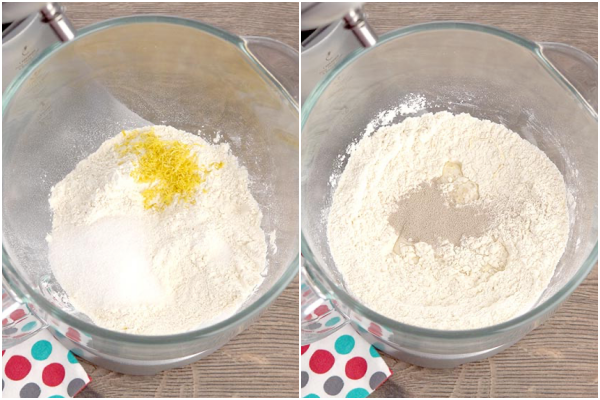
Then add the egg. With the dough hook attachment knead just to combine. Cover the bowl with plastic and let rise in a warm draft free area.

Fold both ends into the middle, repeating 4 times.
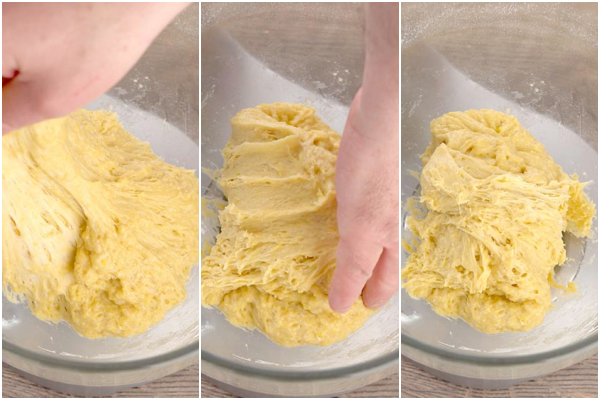
When the time has passed add the butter a little at a time at medium high speed with the dough hook, knead to just combine all the butter, then let the dough rest. Knead again until the dough is smooth and does not stick to the sides of the bowl.
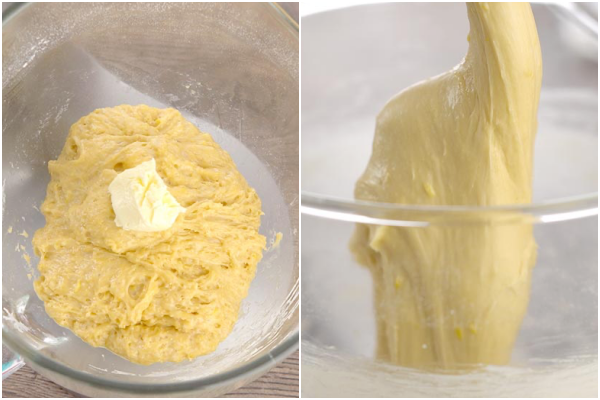
Place the dough in a lightly greased bowl, cover with plastic and refrigerate.
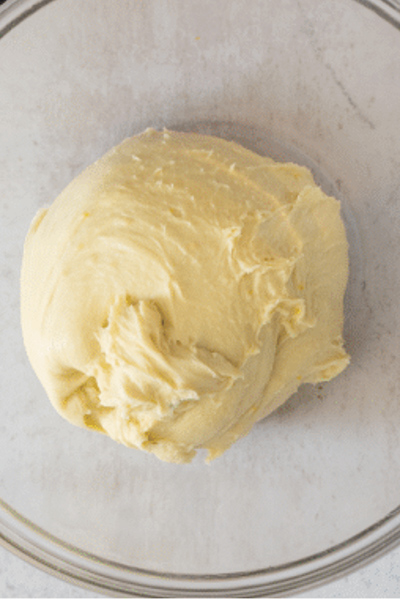
Move the dough to a lightly floured flat surface. Divide the dough into 4 parts. Roll each part into 2 ropes, join the 2 ropes at the top.

Twist the ends one over the other join the ends to form a wreath (circle) repeat with the remaining ropes. Place the wreaths on the prepared cookie sheet, cover and let rise in a warm draft free area until doubled in bulk.
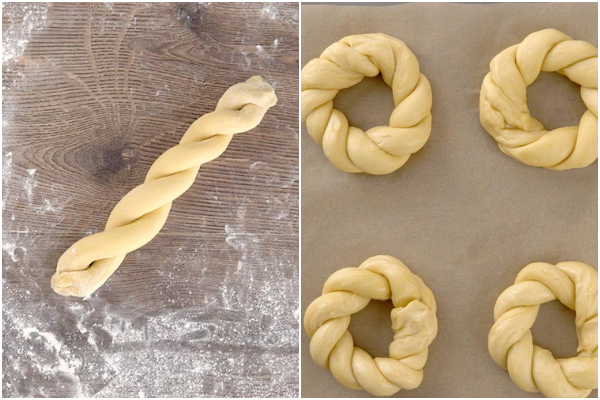
Before baking an uncooked dyed egg can be placed in the dough, then the dough is brushed with a simple egg wash and covered in sprinkles (nonpareils) and baked.

Immediately move the baked bread to a wire rack to cool.
How to know if the dough is proofed perfectly
Proof your dough with the “poke test”. With a fully proofed dough, you should be able to poke it and leave an indent that slowly starts to fill back in but doesn’t spring back completely.
If your dough is under-proofed, it will spring back almost immediately, if your dough is over-proofed it will not spring back at all.
Tips on making the best Easter Bread
- This Italian Easter Bread is a yeast bread which means you need time and patience. It’s not difficult just time consuming but absolutely worth it.
- This dough needs to rise 3x, the first time the dough (without the butter added) is placed in a bowl for 2 hours. Every 30 minutes the dough needs to be folded over.
- The second rise is done once the butter has been added to the dough and then refrigerated for 1-2 hours.
- Believe me they are worth every minute of your time!
This bread is very popular all over Italy. Sometimes I like to make an Easter Bread from the South of Italy, it is a much drier bread and is used as a dunking bread in your morning caffe latte or afternoon espresso or this Easter Sweet bread from the North of Italy. But the most popular Easter Bread which is called Colomba or Dove Bread is also worth a try.
How to colour eggs with Natural Dyes
If you decide to use coloured eggs in your bread and you don’t want to use regular dyes then there are Natural Dyes that you can use. Vegetables and spices are great for dying eggs especially red onions, paprika, dill seed and even red cabbage.

What is the significance of Easter Bread?
Italian Easter Bread when it is baked in the shape of a wreath it is to symbolize the crown of thorns worn by Jesus Christ. When the dough is braided with three pieces it represents the Holy Trinity.
Adding an egg to the bread represents rebirth, Christ rising from the dead.
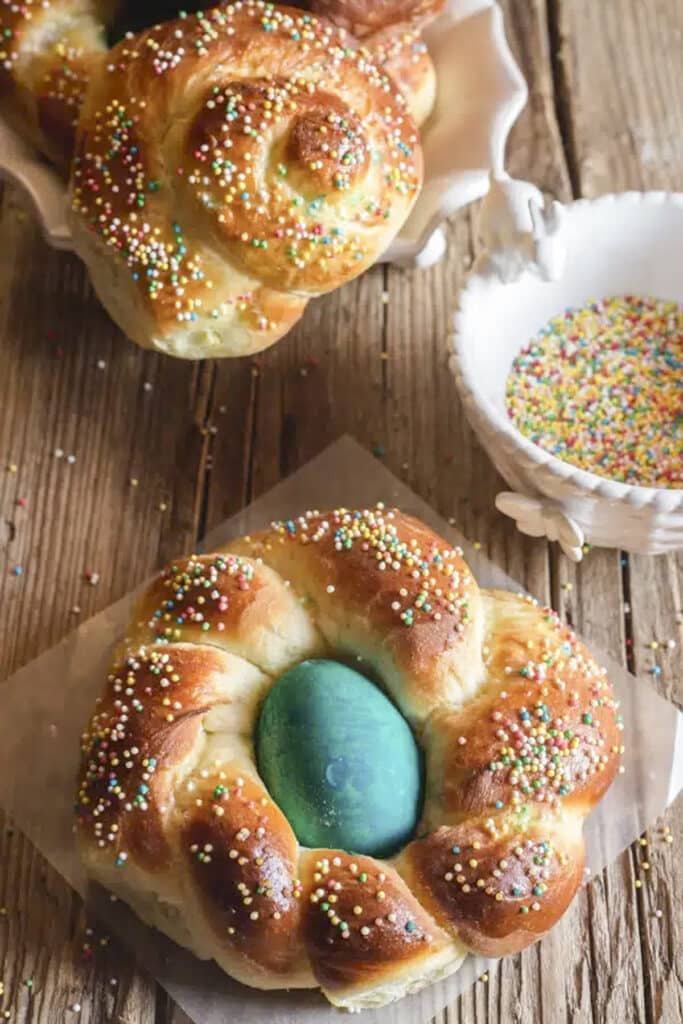
How to Store Italian Easter Bread
Be sure to store the Brioche Bread in an air tight container or bag for up to 5 days. The breads can also be frozen again in an airtight container or freezer bag for up to 2 months. Just be sure to remove the egg before freezing.
So if you would like to surprise your family and friends with a delicious soft Italian Easter Bread, then I hope you give this a try and let me know how you like it. Enjoy!

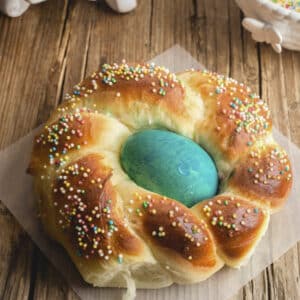
Traditional Italian Easter Bread
Ingredients
BRIOCHE DOUGH
- 1¾ cups +2 tablespoons all purpose flour (234 grams total, if you double or triple the recipe double or triple this amount)
- 1 pinch salt*
- 1 tablespoon lemon zest
- 2½ tablespoons granulated sugar
- ¼ cup lukewarm milk (I used 2 % milk)
- 1½ teaspoons active dry yeast
- 2 eggs (room temperature) (slightly beaten)
- ½ cup butter (room temperature)
If using unsalted butter add ¼ teaspoon of salt.
EGG WASH
- 1 egg
- 1 tablespoon water
TOPPING
- 2-4 eggs (uncooked and dyed whatever colour you like)
- 2-4 tablespoons sprinkles* (if desired)
Instructions
BRIOCHE DOUGH
- In the bowl of a stand up mixer whisk together the flour, salt, zest and sugar, make a well in the centre and add the milk and yeast, mix together with a fork. Then add the eggs. With the dough hook attachment knead for approximately 1 minute just to combine.
- Cover the bowl with plastic and let rise 2 hours, every 30 minutes fold both ends into the middle (repeating 4 times).
- When the time has passed add the butter a little at a time, on medium high speed with the dough hook, knead just to combine all the butter, then let the dough rest 10 minutes. Knead again for 5-6 minutes until smooth and the dough does not stick to the sides of the bowl. Place the dough in a lightly greased bowl, cover with plastic and refrigerate for 1-2 hours.
- Move the dough to a lightly floured flat surface. Divide the dough into 4 parts. Roll each part into 2 ropes (10-12 inches / 25-30cm), join 2 ropes at the top and twist the ends one over the other (see photo), join the ends to form a wreath (circle) repeat with the remaining ropes. Place the wreaths on a parchment paper lined cookie sheet, cover and let rise in a warm draft free area for 1-2 hours or doubled in bulk.
- 15 minutes before rising time has finished pre heat oven to 390F (195C).
- Add a dyed uncooked egg (if desired) to the centre of the wreath then brush the wreaths with the egg wash (be careful not to brush the eggs) and sprinkle with the sprinkles. Bake for approximately 20 minutes or until golden, or when tapped on the bottom and there is a hollow sound. Immediately move the baked buns to a wire rack to cool. Let cool before serving. Enjoy!
EGG WASH
- In a small bowl beat together the egg and water.
Can you the dough proof over night?
Hi Sandra, I have never tried it before, but I am sure you could, sorry for the late reply but with the time difference I was already sleeping. 🙂 Happy Easter!
I left mine in the fridge overnight and just finished baking my first batch… turned out awesome!!
Hi Katie, thanks so much, so glad you enjoyed it. Take care!
Hi! If I don’t have an electric mixer can I just combine and knead with my hands?
Hi Sabrina, yes you can it will take longer but you can certainly do it by hand. Take Care!
Just made this for our Easter brunch this year. I was very nervous because I do not have a great history working with dough.
I followed the recipe exactly – doubled. They turned out perfect. I made 4 wreaths with egg and 3 cross breads all generously sized for sharing. I can’t wait to serve them and have something for guests to take home. They’re beautiful and taste amazing!
Thank you for this wonderful recipe!
Hi Kelly, thanks so much and you’re welcome, so glad you enjoyed it and so happy you shared it. Take care!
I’m confused, if I want to double it, it would be only 468 grams of flour?
When I weighed put just the 1and3/4+tablespoons it is almost 300 grams, so would you not do 600 grams of flour to double it?
Hi Katelyn, when I weigh one cup of flour it weighs 125 grams so, 125 x 1.75 + 2 tablespoons = 234 grams, I don’t know where you get 300 from. Let me know. 🙂
Maybe my flour is not loose when it goes in the measuring cup? How do you ensure it’s loose, I usually just spoon it I’m to my measuring cup and then swipe the top.
Hi Katelyn, I spoon mine in too. 150 grams for a cup of flour is just too much. 🙂
The bread came out perfect, even though my scale said it was almost 600 grams of flour. I think my scale is just wrong.
Anyway, if I wanted to prepare this a day ahead of time and bake it fresh the next day, would I do all of the steps up until the refrigeration step and then just let it go in the fridge overnight for it’s 2nd rise? Then, I would roll it out in the morning and let it sit out in it’s braided loaf form for 2 hours for the 3rd and final rise before baking it?
Hi Katelyn, oh ok, glad it worked out and yes that’s exactly what you should do. Take care!
Measuring the flour by weight is the most accurate representation of how measurements are done in Italian baking.
My dough was very dry when mixed in mixer with dry bits What’s wrong? Should I add a little Mir milk?
Hi Vivian, not all flour absorbs liquid the same, if the dough is too dry add more liquid. 🙂